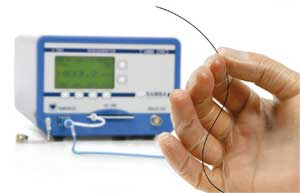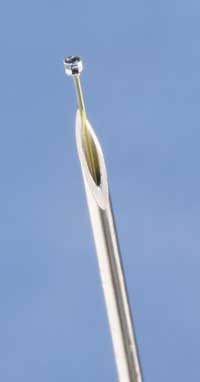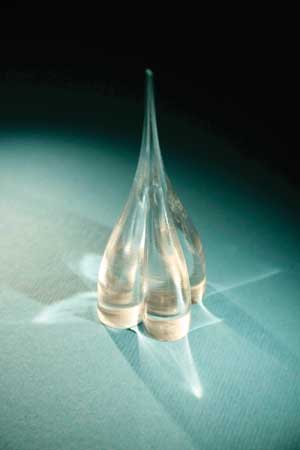Dr. Saeed Rehman, Fibertronix AB, and Asa Claesson,131%% Acreo AB
With the population of the world and the expected average life span both growing, there is a greater demand for efficient tools for diagnostics, surgery and patient care. Minimally invasive surgery is one development toward shorter hospital stays and reduced costs, and specialty optical fibers are helping to pave the way.
Traditional surgery exposes tissues and organs through large incisions, while minimally invasive surgery promises decreased pain and trauma during operations, faster recovery time and a reduced risk of infection. However, the latter requires small disposable sensing catheters and compact tools to assist physicians.

Specialty optical fibers are useful for more than light sources and image collection – they can greatly improve surgical results.
Optical fibers have been used in medical devices since the 1960s, when bundled fibers were successfully pioneered for both illumination and imaging through endoscopes. During the late 1980s, optical fiber imaging tools were widely accepted for invasive surgery. However, optical fibers have the potential to be used in many more applications than imaging and light sources. Special optical fibers also are used as intelligent sensors to monitor physiology parameters such as temperature, pressure, oxygen concentration and applied force.
Fiber optic sensors offer many advantages over conventional electronic sensors in medical sensing: small size, immunity to electromagnetic interference (EMI), enhanced sensitivity, robustness and geometrical versatility. They also are free from electrical parts or conductors in the sensor area. These unique properties have enabled complicated procedures in cardiovascular examinations, angiology, gastroenterology, ophthalmology, oncology, neurology, dermatology and dentistry.

Figure 1. Samba Sensors’ ultraminiature fiber optic pressure sensor is used to sense parameters including systolic blood pressure, intravascular blood pressure and intracranial pressure during trauma. Courtesy of Samba Sensors AB.
The integration of optical fibers in medical devices can be challenging, involving autonomous tasks such as design and selection of fiber, packaging material, cost-effective manufacturing, quality control and traceable record keeping. For example, the sensor assembly must be biocompatible, unaffected by a sterilization process and storage, and resistant to damage during surgery.
A variety of fiber optic sensors have been developed for health monitoring during the past two decades. Point sensors based on Fabry-Perot interferometers and fiber Bragg gratings (FBGs) are probably the most deployed sensors in medical applications. The ultraminiature pressure sensors offered by Samba Sensors AB of Västra Frölunda, Sweden (Figure 1), are a relevant example, capable of sensing intravascular blood pressure or intracranial pressure during trauma. Similar sensors from Fiso Technologies Inc. of Quebec City can be used for intra-aortic pressure sensing (Figure 2). Both rely on clever sensor design and specialty optical fibers.

Figure 2. An FOP-MIV pressure sensor (here inserted in a 24-gauge hypodermic needle) is mass-produced by automated assembly lines. This 550-µm-outside-diameter optical sensor could be integrated into specialized catheters such as intra-aortic balloon (IAB) catheters, where it could provide EMI-free precise in situ blood pressure measurements used to trigger optimal balloon inflation/deflation during IAB pumping therapy. Courtesy of FISO Technologies Inc.
Fiber optic sensors are seen as safe, reliable, highly stable, biocompatible tools for health-monitoring systems, and they are amenable to sterilization and autoclaving. The greatest advantage is intrinsically linked to the special optical fiber, which either acts as a link between a sensor and monitoring equipment or acts as the sensor itself.
Glass is an inert material resistant to almost all chemicals, making it ideal for use in in vitro or in vivo applications. Its immunity against EMI makes it a reliable life-supporting tool in surgical theaters crowded with a range of equipment producing a strong EMI background. Probably the greatest advantage is its size, and the fiber optic sensor can be miniaturized, flexible, light and very useful in space-restricted environments such as instrument catheters for highly localized measurements or for minimally invasive surgery inside blood vessels.
Specialty fibers have played a key role in the wide acceptance of fiber optic sensors as multifunctional diagnostic tools. By modifying properties such as numerical aperture, core and cladding diameters, and coating material, the fibers can be adopted to different applications.
Many optical fibers used in medical sensors have a thin polyimide coating to provide a small cross section and suitability for different kinds of sterilization processes, like ethylene trioxide, ethylene oxide and autoclaving. The polyimide coating provides excellent strength and tight geometry tolerances and can be supplied with any fiber type and with fiber dimensions from 60 µm up to more than a millimeter. The temperature resistance of the polyimide is difficult to match with other polymer materials.
Polyimide-coated fibers, however, are sometimes impractical. They require special tools for removing the coating for assembly, and the thin coating is sensitive during handling. A recent advancement in biocompatible coatings could replace current standard acrylate-coated fibers. The new Fibertronix coating can be easily stripped from the fiber using standard tools. It shows excellent strength and robustness and can be pigmented into a variety of colors. It also opens many yet-to-be-explored applications for patient diagnosis and prognosis.
Another highly desirable parameter of fibers for invasive surgery is tolerance to tight bends. This allows for movement of the catheter, which winds through veins and arteries, and around organs and bones, on its way to an application area. It is very important that the fiber not break or lose optical transmission at bends. The numerical aperture of the fiber influences how much the light is confined within the core and dictates how tightly the fiber can bend before optical bend loss occurs. A range of high-numerical-aperture single- and multimode fibers is available on the market, and a small number can even be tightly bent and wound to diameters as small as 3 to 4 mm with minimum optical loss.
These fibers are inserted in space-constrained catheters, so their outer diameter should be as small as possible without sacrificing light or mechanical durability. An 80-µm cladding fiber is an ideal choice for such applications. A number of single-mode 80-µm fibers are available from various suppliers, and these reduced-clad fibers are excellent choices for compact sensing solutions. New multimode reduced-clad fibers are well adapted for catheter-mounted sensing solutions. In reduced-clad fibers, high numerical apertures often further reduce optical bend losses. For special applications, fiber diameters down to 60 µm or lower can be produced, but these fibers are difficult to handle, so 80 µm is seen as a practical lower limit for most applications.
Novel specialty fiber types are also opening up entirely new sensing concepts. Something a surgeon needs is information about the shape, direction and position of an instrument during minimally invasive surgery. A combination of multicore specialty fibers with FBG technology can provide this. In this type of fiber, three or more cores run in parallel, and each core has an FBG inscribed at the same position in the fiber.

Figure 3. Gemini preform and drawn fiber. Courtesy of Acreo AB.
The basic concept is that when the fiber is deformed, it will induce strains of different magnitude and curvature in each of the FBGs. Because all cores are in physical contact, they will all experience the same temperature shifts and ambient. When such sensors are embedded in or fixed on the surface of the surgical tool, they can map out real-time information about the position and direction of the tool, independent of the temperature or the environmental load.
This sensor concept provides a way to dynamically monitor the position and shape of a catheter or fiber cable in blind spots and has been enabled by multicore FBG sensors. In the Fibertronix Gemini fiber, for example, the multicore fiber is replaced by independent fibers physically attached to each other in an all-glass assembly; the drawbacks of the multi-core fiber, such as difficult contacting and handling, are overcome.
Meet the authors
Dr. Saeed Rehman is vice president of business development at Fibertronix AB in Hudiksvall, Sweden; e-mail: saeed@fibertronix.com. Asa Claesson is manager at Acreo Fiberlab in Hudiksvall.
/Buyers_Guide/Fibertronix_AB/c18038